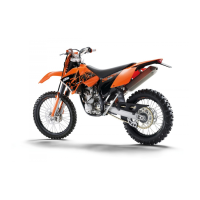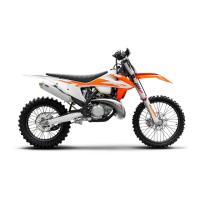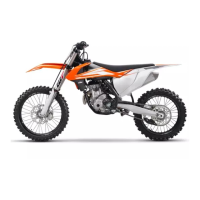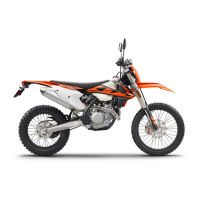MAINTENANCE WORK ON CHASSIS AND ENGINE »
ENGLISH
38
min.
1 mm
1
2
3
4
5
6
A
B
Checking the rear brake pads
The brake pads can be inspected from the rear. The thickness of the linings
may not be less than 1 mm (0.04 in).
At their most worn point brake pad linings should not be thinner than 1 mm,
otherwise they could lead to brake failure. For your own safety don’t put off
having your brake pads changed.
If the brake pads are replaced too late so that the lining is partly or entirely
worn, the steel components of the brake pad will rub against the brake disc,
thereby imparing the braking effect and destroying the brake disc.
Replacing the rear brake pads *
Push the brake caliper [1] toward the chain wheel in order to move the brake
piston into its basic position. Remove the clips [2], pull out the bolt [3], and
remove the brake pads. Thoroughly clean the brake caliper with compressed
air and check the sleeves of the guide bolts for damage.
Insert the left brake pad into the brake caliper and secure it with the bolt.
Insert the right brake pad and push the bolt [3] into the brake caliper up to
the stop. Reattach clips [2].
– It is very important to keep the brake disk free from oil and fatty matters.
Otherwise, the braking effect would be strongly reduced.
– After assembly, check if clips have been fitted correctly.
– After working on the braking system, always actuate the hand brake lever
or foot brake lever, respectively to ensure that the brake pads will lie against
the brake disk and the pressure point is established.
Dismounting and mounting the front wheel
To remove the front wheel, jack the motorcycle up on its frame so that the
front wheel no longer touches the ground.
Loosen the 2 clamping screws [4] on the left side of the fork fists.
Loosen and remove the collar nut [5]., loosen the clamping screews [6] on
the right side of the fork fist.
Hold the front wheel, pull out the wheel spindle [7].
NOTE: The wheel spindle can be easily removed if you slightly revolve it with
a ring spanner (SW 27 mm).
Carefully remove the front wheel from the fork.
– Do not operate the hand brake when the front wheel has been dismounted.
– Make sure the brake disc is always on top when you lay down the wheel,
otherwise the brake disc can be damaged.
Before remounting the front wheel, clean and grease the shaft seal rings [A]
and the bearing surface [B] of the distance bushings and mount the distance
bushing.
To install the front wheel, lift it into the fork, position and mount the axle
shaft. Mount the collar nut [5], tighten the clamping screws [6] on the right
fork leg axle passage to prevent the axle shaft from turning and tighten the
collar nut to 40 Nm (30ft.lb).
Loosen the clamp screws on the right fork leg. Take the motorcycle down from
its stand. Press the front wheel brakes and push down on the fork a few times
vigorously so that the fork legs come into alignment.
Only after this has been accomplished, tighten the clamp screws on both fork
legs with 15 Nm

